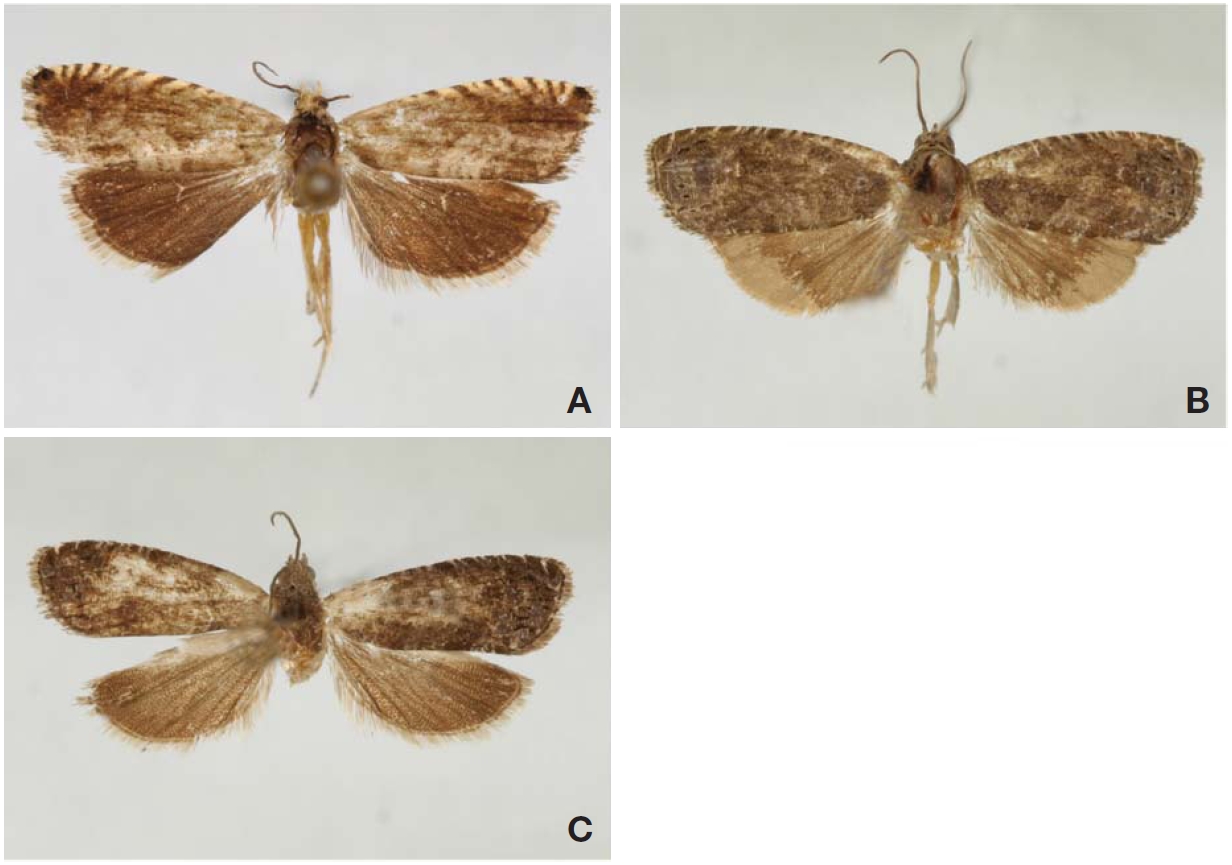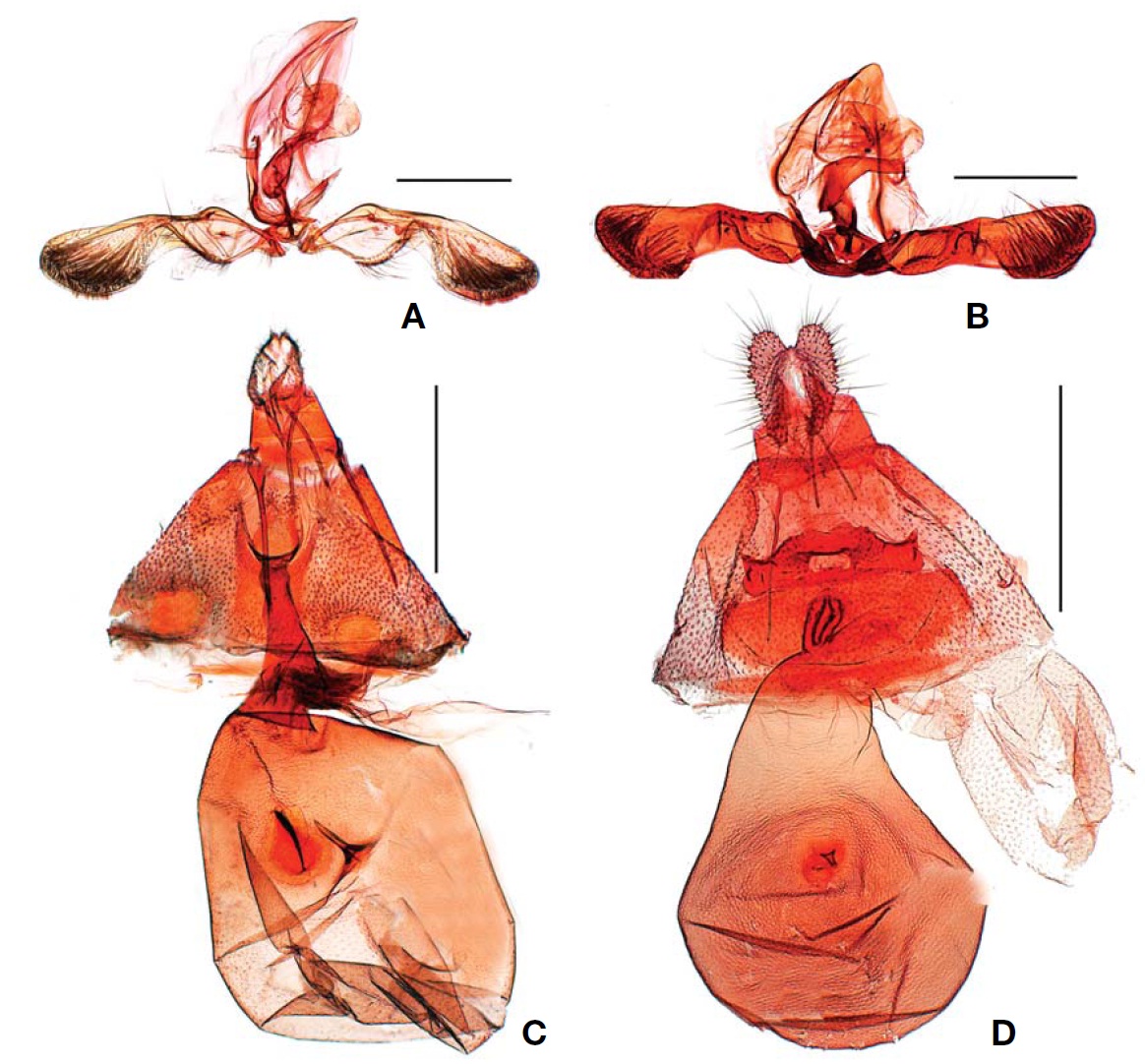



Genus
In North Korea, the first report of the family Tortricidae, comprising 34 species, was made by Zhu (1969). It includes three species of the genus
Later, Park and Byun (1991) reported 26 species of the family Tortricidae from North Korea, with the material deposited in the Hungarian Natural History Museum, Budapest, Hungary (HNHM). However, there was no additional species for the genus in their report.
Jaros et al. (1992) reported 28 new records of Tortricidae from Korea, based on the material Czech Academy of Sciences, Prague, Czech Republic (CAS). Byun et al. (1998) enumerated 350 species of Korean Tortricidae, citing 63 species of Tortricinae and 40 species of Olethreutinae which had been identified in North Korea. Later Razowski (1999) provided a list of Korean Tortricidae with additional data, indicating 176 species of the Tortricidae from North Korea, based on previous reports and the specimens at Polish Academy of Sciences, Krakow, Poland (PAS). Despite these studies, only one species,
Although
Material examined in this study was based on the collection in the HNHM. Genitalia of the species were mounted in Euparal media. Images were captured using an iCM 3.0 IMT i-Solution Inc. digital camera (Vancouver, Canada) attached to a Nikon MMZ 800 microscope (Yokohama, Japan). The color standard for the description of adults was based on the Methuen Handbook of Colour (Kornerup and Wanscher, 1978). Abbreviation used in this study is as follows: TL, type locality; GS, genitalia slide number.
Order Lepidoptera Linnaeus, 1758
Family Tortricidae Latreille, 1803
Genus Grapholita Treitschke, 1829
The genus
Key to the genus
1. Head ochreous, vertex brownish gray, suffused with dark gray. Dorsal blotch of forewing distinct, consisting of two pairs of long striae ????????????????????????????????????
- Head with vertex dark gray or fuscous. Dorsal blotch of forewing indistinct, with no two pairs of long striae; variation present in hindwing ???????????????????????????????????????????2
2. Hindwing in male slightly concaved near dorsum at lower termen ?????????????????????????????????????????????????????
- Hindwing in male not concaved, with large, grayish paleyellowish brown patch in outer area near termen ???????????????????????????????????????????????????????????????????????????????
Grapholita delineana Walker (Figs. 1A, 2C)
Material examined. 1♀, Prov. South Pyongan, Bongwari, 45 km from Pyongyan, 16-17 Aug 1971, Harvatovich S, Papp J, GS 077; 1♀, Prov. South Pyongan, Pyongyang Hotel garden, 31 Aug 1971, Harvatovich S, Papp J, GS 079.
Description. Adult (Fig. 1A). Wingspan 11-12 mm. The species differs from others by the presence of four whitish parallel lines arising from the dorso-middle part of the forewing. It is one of the common species which is easily collected on
Female genitalia (Fig. 2C): Papillae anales narrow with numerous short hairs. Sterigma subquadrate in shape. Ostium bursae broad, rounded at entrance, funnel-like in outline. Ductus bursae as long as half of corpus bursae, wide in diameter, well sclerotized from entrance to middle, then slightly widened towards corpus bursae. Corous bursae large, ovate, somewhat long, having two different signa: one with wide tongue-like and the other nail-shaped. Ductus seminalis ovate, balloon-shaped with a slightly narrow entrance, somewhat wider in diameter than ductus bursae, originating from before the entrance of corpus bursae.
Distribution. Korea (S, N), China, Taiwan, Japan, Russia (Far East), India (Assam), New Guinea, Iran, Europe.
Host plant.
Remarks. It has two generations per year and hibernates as larva within cocoon in soil or between seeds. Generally one individual of larva is able to eat seven or eight immature seeds. Larvae attack
Grapholita dimorpha Komai (Figs. 1B, 2A)
Material examined. 1♂, Prov. South Pyongan, Pyongyan, Hotel garden, 14 Aug 1971, Horvatovich S, Papp J, GS 085; 1ex, Prov. South Pyongan, Pyongyan, Hotel garden, 5 Aug 1971, Horvatovich S, Papp J.
Description. Adult (Fig. 1B). Wingspan 11-14 mm. This species is very similar to
Male genitalia (Fig. 2A): Uncus atrophied, somewhat narrowed terminally. Valva narrow, deeply concave at lower middle area, with costa gently curved downwards; cucullus soatulate, rather broad and rounded terminally, covering with numerous stout spines along lower margnal area; sacculus narrow, a bit thick bearing long hairs ventrally, with a wide semi-circle cavity basally. Aedeagus wide basally, slightly curved, narrowed terminally; cornuti with a series of short filiform thorns.
Distribution. Korea (S, N: new record), Japan.
Host plant. Japan:
Grapholita inopinata (Heinrich, 1928)
Material examined. Unknown.
Description. Wingspan, 10-11 mm. This species has been known as Northeast Asian species. In this study, we could not found its specimens from North Korea in HNHM.
Distribution. Korea (uncertain), China, Japan, Russia.
Host plant.
Remarks. It has two generations per year in China, and hibernates as matured larva between branches or stems. Adults emerge in late May to late June. Female adults lay eggs singly on each fruit. Eggs hatch in about 6 days. Newly hatched larvae feed into fruit, and thereby the injured area turns reddish brown. Larvae are fully grown after about 18 days. Mature larvae come out from fruit to find any gap to pupate by making a cocoon. Pupae emerge after 8-10 days. Moths appear from mid-July to mid-August. Larvae of second generation mature until late September and begin to hibernate (Liu, 1983; Liu and Li, 2002). During the course of the pre-
sent study, no specimen in HNHM was found from North Korea.
Grapholita molesta (Busck) (Figs. 1C, 2B, D)
Material examined. 1♀, Prov. South Pyongan, Pyongyang Hotel garden, 12 Aug 1971, Harvatovich S, Papp J, GS 017; 1♂, Prov. South Pyongan, Pyongyan, Hotel garden, 12 Aug 1971, Horvatovich S, Papp J, GS 076.
Description. Adult (Fig. 1C). Wingspan 12-14 mm. This species is one of the cosmopolitan species. It is quite similar externally, but can be distinguished by the hindwing with grayish pale-yellowish brown patch and straight costa of valva in male genitalia.
Male genitalia (Fig. 2B): Uncus atrophied, somewhat pointed and slightly emarginated terminally. Valva narrow, strongly concaved at medio-ventral area, with costa nearly straight; cucullus spatulate, rather broad and rounded terminally, having stout spines along lower and lateral margin; sacculus narrow, weakly sclerotized. Aedeagus broader basally, slightly curved at middle, narrowed beyond middle; cornuti consisting of a series of short spines.
Female genitalia (Fig. 2D): Papillae anales broad, broder posteriorly. Apophyses anetriores as long as half of apophyses posteriors. Stergma large, strongly sclerotized, with two shortly projections post-laterally, slightly emarginated before these projections. Ostium bursae small, quadrate in outline. Ductus bursae very short, well sclerotized inside. Ductus seminalis large, ovate, rather broad at entrance, originated from the entrance of corpus bursae. Corpus bursae large, pear shaped, with two small thorn like signa of differing size.
Distribution. Korea (S, N), China, Taiwan, Japan, Europe, America (North), Mexco, Australia.
Host plant.
Remarks. The species completes three or four generations a year in pear farms in China and overwinters as matured larva within a grayish white cocoon at base of trunks, fruit boxes, stones, and between bark. Female adults lay eggs beneath new leaves. Hatched larvae bore into new branches. Larvae of the second generation appear in July to August. In severe infestations, fruits may be surrounded by blackish frass, which is a specific symptom distinguished from other species (Liu, 1983; Liu and Li, 2002).
Genus

